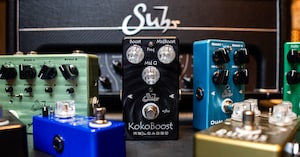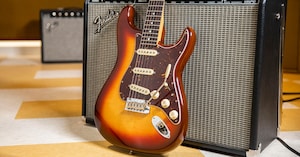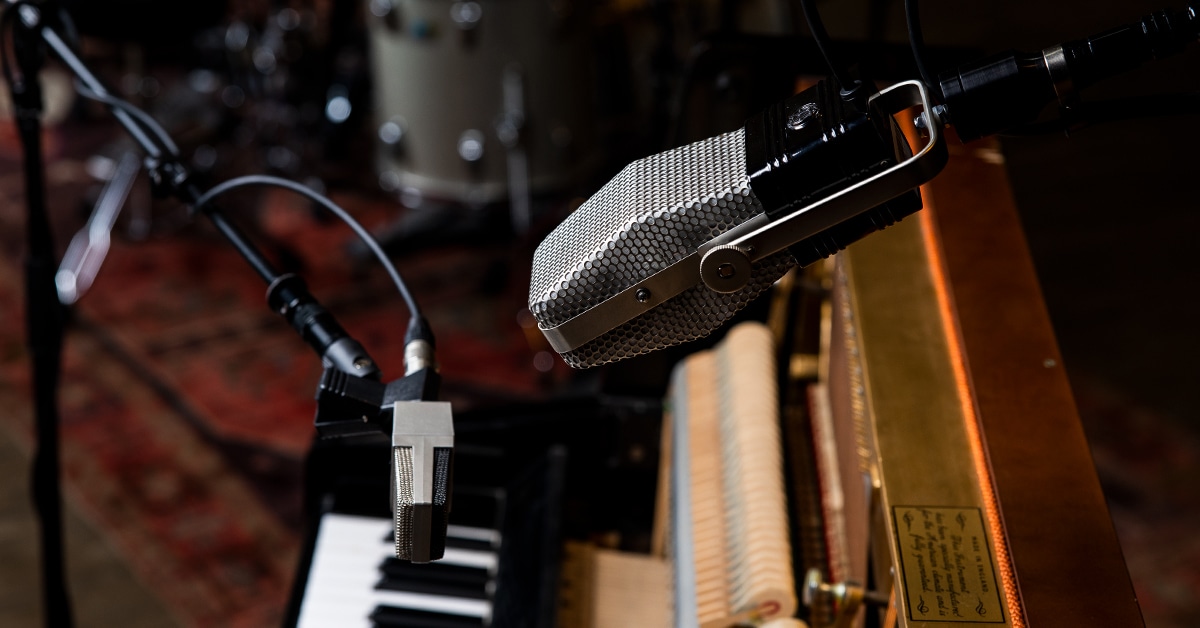Guitarist, songwriter and Grammy winner Annie Clark, best known as St. Vincent, is a music industry iconoclast. She is endlessly inventive, experimenting with surprising arrangements, intricate lyrics and bold sounds. In 2015, she partnered with Ernie Ball Music Man to create a guitar as distinctive as she is, with elegant design, remarkable versatility and an abundance of luxurious tone.
This interview was originally conducted in February of 2016 at Mack Sennett Studios in Los Angeles.
The St. Vincent sound is a fierce, sophisticated one that has drawn comparisons to Kate Bush, David Bowie, Siouxsie Sioux and David Byrne, the latter of whom Clark collaborated with on the 2012 release Love This Giant. She’s an innovative guitarist and fearless artist, known for exploring new effects and tones since the earliest days of her career, performing with The Polyphonic Spree and Sufjan Stevens while developing her solo work. “I think that over the years of playing in different bands and being a sideman and figuring out what the role of guitar was going to be in St. Vincent … I’ve had to have the guitar be a real shapeshifter,” Clark says. “That’s where the experimentation came in.”
That experimentation has led her to a number of unusual guitars over the years, including Silvertones, Hagstroms, a Harmony Bobkat and, most recently, the Ernie Ball Music Man Albert Lee. “I started playing the Albert Lee by [Ernie Ball] Music Man, and I really liked it for this tour I did with David Byrne because I really needed to be a jack-of-all-trades guitar player,” she explains. “It was a really comfortable and versatile guitar for that.” A trip to California and a meeting with Ernie Ball Music Man CEO Sterling Ball was the impetus for an entirely new guitar. “I went to San Luis Obispo and met everyone at Ernie Ball, and they showed me the factory, and it was like seeing Willy Wonka’s chocolate factory,” she says. “Sterling said, ‘Well, why don’t you draw a guitar? Why don’t you draw us shapes that interest you?’”

Beginning with a striking silhouette, the St. Vincent guitar was born. “I really like things that are angular and kind of straddle that balance of … retro and future,” she says. “I also wanted to make sure that there was something that was going to be really light, because I’m a small person, and a lot of guitars that I really love and that sound really great are just too heavy for me to play … and then the shape of the body—I like to think it’s a gender-inclusive model. So, I sketched something up and worked with Sterling and Drew [Montell, Research and Development Engineering Manager] over at Ernie Ball, and then it was just a process of refinement.” The aerodynamic African mahogany body is both lightweight and resonant, and it’s available in black or a custom St. Vincent Blue hand-mixed by Clark herself.
“This guitar is its own animal, but it was certainly influenced by some of my favorite guitars,” she says. “The neck of the Albert Lee, the weight of a Harmony Bobkat. Also, the whammy bar on a Harmony Bobkat, because it’s just really brutal. But the plus side of this guitar is that it actually stays in tune … Those are kind of my two touchstones—the Albert Lee and the Harmony Bobkat.”
The all-rosewood neck adds sustain and warmth, in addition to a distinctive look. “I loved the shape and the feel of the Albert Lee and the rosewood neck, so I pretty much lifted that and put it on my guitar,” she says. The frets are marked with the stylized “S” of the St. Vincent logo, and the headstock features the full logo in lieu of the full St. Vincent name or a signature—a conscious choice to make the guitar more accessible.
“This is a signature model in that I worked with Ernie Ball to design a guitar that was based on my very specific needs and desires in a guitar, and [we] really made a great instrument that I love playing and that is transferrable to other people, so I didn’t want to go too heavy-handed with the branding,” Clark explains. “I wanted to get it in the most people’s hands as possible and not have people be put off by that.”
The body is stocked with three DiMarzio custom mini-humbuckers with a 5-way selector that isolates each pickup respectively in positions 1–3, activates all three in parallel in position 4, and selects only the bridge and neck pickups in parallel at position 5. “The pickup configuration is a little unconventional,” she says. “I wanted to have the maximum of tone diversity, and I also know which pickups I usually used on the Albert Lee and with the Harmony Bobkat.”
And what should guitarists expect when they pick up this guitar for the first time? “It’s almost like wearing a really nicely tailored suit,” Clark says. “It just makes you look good. It just makes you look better than you are. I feel that with this guitar all the time. Like it makes you sing … and it’s a tone monster. It’s really versatile. It can be a little pocket rocket, or it can be really sensitive.”
Clark relies on a wide array of gear to get the appropriate sound for each St. Vincent song. In live performance, she uses a vintage Ernie Ball Music Man 115 B250 bass amp. “What I like about the [Ernie Ball] Music Man bass amp from the ’70s that I use is that it has really specific tone controls. It doesn’t just say, you know, ‘Bass, Mid, Treble.’ It gives up the EQ spectrum, and so you can boost really specific things,” she says. Her heavy touring schedule demands a compact setup, and the B250 fits the bill, as do Kemper Profiler modeling amps. “When I’ve been on the road, you weigh out a lot of things, and one of those things is space and weight and footprint because you’re flying all the time. You’re scooting around. You got one gig in Poland one day, and another gig in Glasgow the next. So, on the road, I was using the Kemper modeling amplifiers … I know that Nine Inch Nails were using them. Pino Palladino had them in his bass rig, and so I bought a couple of those off the Nails, and they’re great.” She adds, “They weigh nothing, and if they’re good enough for Trent Reznor, they’re good enough for me.”
Clark requires a large amount of effects in as streamlined and space-saving a setup as possible, and she keeps it carefully programmed to cut down on mid-song footwork. “My last touring rig had some ZVex stuff in it. It had a couple of Eventide H9s, which are good for footprint and tone flexibility,” Clark says. “My show is very programmed guitar-wise … there’s no way that I could be switching from kind of rhythm things to lead things, and all the tone variations and everything I ask the guitar to be in the orchestrations, without having my board programmed, and having MIDI messages sent to it on certain cues. I couldn’t do the tap dance to change all those parameters instantly, so there’s a lot of thought put into the footprint and in using technology to our advantage.”
It’s important to note that the signature guitar, the very cool vintage gear and dazzling effects exist to serve Clark’s considerable songwriting and performance craft. As her style has evolved from record to record, she has refined her songwriting process. “Melody is where I always start,” she says. “And that melody, it could be sung or it could be transferred onto guitar. It’s really, really fluid … sometimes it’ll be about a beat. But sooner or later, you have to get around to a melody, so that’s kind of king.” She develops the songs in her own workspace, fleshing out ideas with guitars, drum machines and keyboards. “It’s all kinds of stuff, and nothing is sacred. Nothing has to end up how it started, except for the emotional core.”
In addition to her critically acclaimed solo releases, Clark has also taken part in notable collaborations, from guest appearances to co-writing, working with artists such asThe National, Andrew Bird and Bon Iver, to name a very few. “Collaboration is always so fun because, at a certain point, you kind of know what you do a little bit without being boxed in. You know where your strengths are. You know where your weaknesses are. But, when you get together with another person, then that really doesn’t matter. It gets to be this third thing. You get to do what you wouldn’t do.” She notes her tour with David Byrne as an example of the importance of an artist leaving her or his comfort zone. “We had eight people on stage, a brass band … and all the songs were really funky and people would get up at the shows and dance. I was like, ‘Oh, my God, what a revelation.’ Nobody ever danced at my shows. Maybe cried quietly in the background. Nobody ever danced, and I certainly took that inspiration forward.”
It’s this spirit of discovery and collaboration, a sense of artistic openness and authenticity, that brings such excitement to Clark’s music, making St. Vincent beloved by fans, critics and other artists. “Music’s the best thing. It’s the most fun. It’s the most rewarding,” she says. “You just always think that your best song is ahead of you … I have an amazing life thanks to music, and I can’t think of anything better. It’s what gets me up in the morning. I cannot think of anything that I would rather be doing in the world.”
Check out the Ernie Ball Music Man St. Vincent today.










